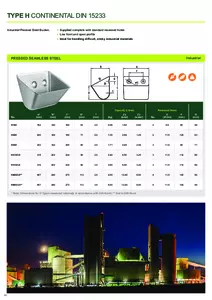Continental Buckets (DIN 15233)
H-Type Industrial Buckets
H160, H200, H250, H315/2.0, H315/3.0, H400/2.0, H400/3.0
Industrial pressed steel elevator bucket.

Product Features
- Supplied complete with standard recessed holes
- Low front and open profile
- Ideal for handling difficult, sticky industrial materials
Material
Stainless Steel,
Steel
Use by Industry
Industrial
Use by Product
Cement,
Light Industrial,
Heavy Industrial
Specifications

| H-TYPE | A | B | C | D* | T | Weight | Capacity | Capacity | Holes | E | F | G | |
| Continental bucket | (mm) | (mm) | (mm) | (mm) | (mm) | (kg) | Z2 (total) | Z3 (water) | No. | (dia mm) | (mm) | (mm) | |
| H160 | 162 | 140 | 160 | 63 | 2 | 0.98 | 1.8 | 0.8 | 2 | 9.5 | 80 | 56 | |
| H200 | 200 | 160 | 180 | 71 | 2 | 1.3 | 2.84 | 1.29 | 2 | 11.5 | 125 | 63 | |
| H250 | 253 | 182 | 200 | 80 | 2 | 1.71 | 4.45 | 2.06 | 3 | 11.5 | 80 | 71 | |
| H315/2.0 | 315 | 202 | 224 | 90 | 2 | 2.4 | 6.5 | 3.2 | 3 | 11.5 | 112 | 80 | |
| H315/3.0 | 315 | 202 | 224 | 90 | 2 | 3.6 | 6.5 | 3.2 | 3 | 11.5 | 112 | 80 | |
| H400/2.0** | 407 | 240 | 275 | 113 | 2 | 4 | 13.4 | 6.5 | 4 | 11.5 | 100 | 90 | |
| H400/3.0** | 407 | 240 | 275 | 113 | 2 | 6 | 13.4 | 6.5 | 4 | 11.5 | 100 | 90 |
* Note: Dimensions for H Types measured internally in accordance with DIN norm.
** Not to DIN norm.









